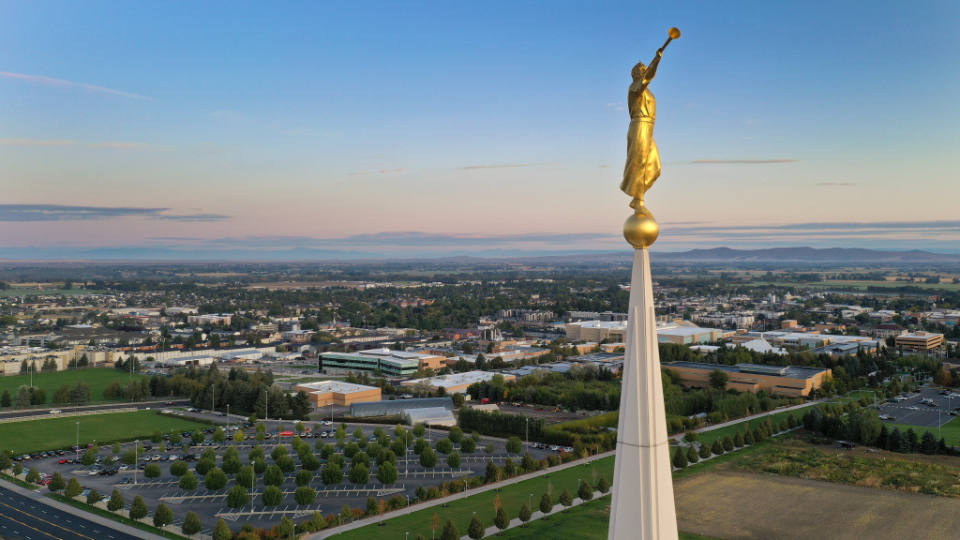
BYUI-20-Anniversary
The BYU–Idaho campus and the Rexburg Idaho Temple in Rexburg on Monday, September 23, 2019. Photo by Jeffrey D. Allred, courtesy of Church News.Copyright 2021 Deseret News Publishing Company.This story appears here courtesy of TheChurchNews.com. It is not for use by other media.
By Rachel Sterzer Gibson, Church News
On June 23, 2000, President Gordon B. Hinckley made an announcement that would prove to be monumental to the future of the Church Educational System.
Standing in the Church Administration Building in downtown Salt Lake City, the President of The Church of Jesus Christ of Latter-day Saints announced the transformation of Ricks College from a two-year junior college to Brigham Young University–Idaho, a four-year institution.
After a little more than a year of gradual but substantial changes, on August 10, 2001, the school was ready to officially use the BYU–Idaho letterhead and answer the phone with, “Hello, Brigham Young University–Idaho.”
That day, now 20 years ago, was an integral step in the Lord providing the blessing of education to thousands more of His children on the earth.
One of the greatest challenges of Church education — then and now — continues to be how to create opportunities for more students to attend Church institutions of higher education, Elder David A. Bednar of the Quorum of the Twelve Apostles told the Church News.
Elder Bednar, who served as president of the school during its transition from Ricks College to BYU–Idaho, said, “The creation of BYU–Idaho was one of the most important educational events of the Restoration.”

BYUI-20-Anniversary
Students leave the BYU–Idaho Center after listening to Elder David A. Bednar of the Quorum of the Twelve Apostles of The Church of Jesus Christ of Latter-day Saints during a fireside at BYU–Idaho in Rexburg on Sunday, September 22, 2019. Photo by Jeffrey D. Allred, courtesy of Church News.Copyright 2021 Deseret News Publishing Company.Prophetic Design
Elder Bednar recalled President Hinckley’s phone call to him at Ricks College, when the Church President said it was time to make the junior college a four-year school.
In the ensuing conversation, the two determined that BYU–Idaho should fulfill a distinctive mission and strive to bless a larger number of students.
In the June 23, 2000, announcement, President Hinckley explained that the school would “have a unique role in and be distinctive from the other institutions of higher education within the Church Educational System.” The university would report directly to the commissioner of the Church Educational System, which means it would have its own identity and function.
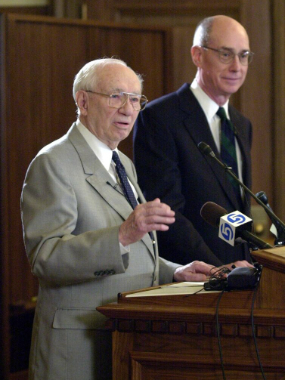
BYUI-20-Anniversary
President Gordon B. Hinckley and Elder Henry B. Eyring announce plans to change Ricks College into BYU–Idaho, a four-year institution. Photo by Ravell Call, courtesy of Church News.Copyright 2021 Deseret News Publishing Company.In his 450-word, six-paragraph announcement, President Hinckley outlined the exact parameters for the university’s design.
“[The announcement] lays out a framework, and you look at it 20 years later and say, ‘Well, this is what actually has happened,’” Elder Clark said.
Elder Clark G. Gilbert, a General Authority Seventy and the new commissioner of Church education, served as president of BYU–Idaho from 2015 to 2017 before becoming the first president of the Church’s new online education provider, BYU–Pathway Worldwide.
After being called to serve as president of BYU–Idaho, Elder Gilbert recalled poring over many of the school’s foundational documents and speeches, including President Hinckley’s announcement.
“As I read President Hinckley’s announcement, I realized not only did he announce the creation of BYU–Idaho, he announced a very different kind of university. That was our birthright, and I knew BYU–Idaho needed to live within the distinctive parameters of that birthright. Without this distinctive design, the Church would have left the institution as a community college,” Elder Gilbert explained.
What exactly is BYU–Idaho’s birthright? President Hinckley said the university would continue to be teaching-oriented, and that would be the faculty’s primary focus. The institution would emphasize undergraduate education only and would not offer graduate degrees. Because faculty would not be focused on research and the school would not offer graduate programs, the campus could operate “on an expanded year-round basis.”
In addition, BYU–Idaho would take advantage of “advancements in technology,” which would allow it to serve more students. It would also discontinue intercollegiate athletics and “shift its emphasis to a year-round activity program designed to involve and meet the needs of a diverse student body.”
In essence, the Prophet created a distinctive model in higher education that is unique across all academia “in a one-page announcement,” Elder Gilbert noted.
Rob Garrett, the current vice president of enrollment at BYU–Idaho, said President Hinckley’s announcement is still used as a touchstone for administrators when making decisions today. “When there are new things or innovations to consider, I think it’s really important to us to not stray or drift from that announcement when BYU–Idaho was made,” Garrett said.
When Elder Gilbert became president of the university, he said he began to recognize the “tremendous pressures” academic culture places on universities to conform to more traditional models in higher education, such as adding graduate programs and increasing faculty research.
However, he felt strongly that BYU–Idaho had to remain grounded in the birthright the Prophet provided. “BYU–Idaho will only be able to continue to lead as it lives within its birthright. It is this student-focused discipline that allows it to be unique and create differentiated impact in the lives of its students. If BYU–Idaho ever lets go of this focus, it will lose its distinctive advantage and its prophetic differentiation,” Elder Gilbert said.
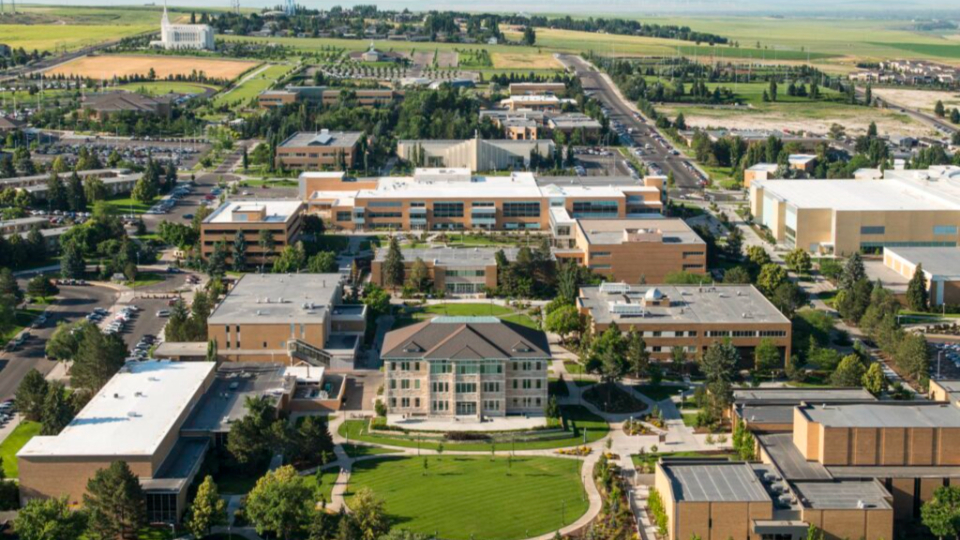
BYUI-20-Anniversary
Aerial photos of BYU–Idaho in Rexburg. Photo by Michael Lewis, BYUI. Courtesy of Church News.All rights reserved.Why Rexburg?
The campus of Ricks College, now BYU–Idaho, sprawls over more than 400 acres on a hill overlooking the city of Rexburg and the Snake River Valley. Those who have experienced a winter there can tell tales of icy winds and deep snowdrifts. The small town is roughly 20 miles from I-15 — the primary north-south highway of Eastern Idaho.
Elder Clark explained that the area was settled by faithful Latter-day Saint pioneers who made it their home despite the 1870 National Geographic Service deeming the area “uninhabitable.” These hardy pioneer settlers founded the Bannock Stake Academy in 1888. The school was later named Ricks Academy (1902–1917), after city founder Thomas E. Ricks, then renamed Ricks College (1917–2001).
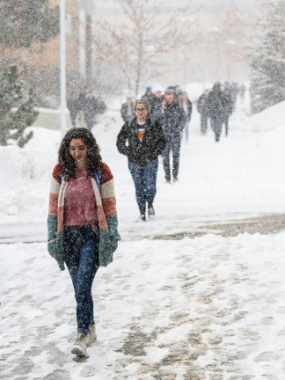
BYUI-20-Anniversary
Students walk to a devotional at the BYU–Idaho Center in Rexburg, Idaho, on January 28, 2020. Photo by Lawson Turcotte, courtesy of Church News.Copyright 2021 Deseret News Publishing Company.Elder Bednar said heaven had a hand in the establishment of Ricks College and BYU–Idaho. “Why else would you build a school in Rexburg, Idaho? It’s not on the freeway, and it’s not close to anything, if you think about it. It’s been preserved, it’s been enlarged in really miraculous ways because heaven has an interest in what goes on there,” Elder Bednar said.
BYU–Idaho’s location was “paramount to the miracles that happened there” for three reasons, Elder Gilbert explained. First, “You would only go there as a student, as a faculty member or as an administrator if you knew the Lord wanted you there.”
Second, there’s a historical modesty, frugality and caring that’s rooted in the history of Rexburg. “That pioneer’s heart is still embedded in the culture of the university because of its roots as a frontier academy where people were consecrated to the Lord. They knew how to work hard and do more with less.”
Third, the school’s isolation provides a release from the pressures of the world and the pressures of academia. “You aren’t constantly comparing yourself to other universities. You aren’t constantly trying to be like the world. It is carved out and set apart from the world,” Elder Gilbert said.
When Elder Clark left his position as dean of Harvard Business School to come to Rexburg, some of his Harvard colleagues expressed concern. After attending his inauguration, however, one of those colleagues told him, “We’re not worried anymore. You have great people.”
The Lord brings extraordinary people there, said Elder Clark of Rexburg, “not just in terms of their talent but their faith, their consecration and their willingness to do whatever is needed. And that’s how we can work miracles through them because of their goodness.”
The Transition
Bob Wilkes will never forget the day President Bednar came to his office in the Kimball Building on Ricks College campus to ask what he thought about the school becoming a four-year university and offering bachelor’s degrees.
It wasn’t uncommon for the college president to pop his head into the vice president of student life’s office and address issues and questions concerning the campus, but this question surprised Wilkes.
“I said, ‘That would never work,’” Wilkes recalled during a Church News interview. He then explained his reasons to President Bednar.
President Bednar listened, Wilkes said, and then asked, “Would it make any difference if you knew that President Hinckley thought it might be a good time to do that?”
“I said, ‘That would make all the difference, President.’”
Wilkes, who later served as interim president between President Bednar’s call to the Quorum of the Twelve Apostles and Kim B. Clark’s installation as university president, said his response was indicative of many faculty and employees. “Once we knew it was coming from the Prophet, there was no more debate about it or question about it.”
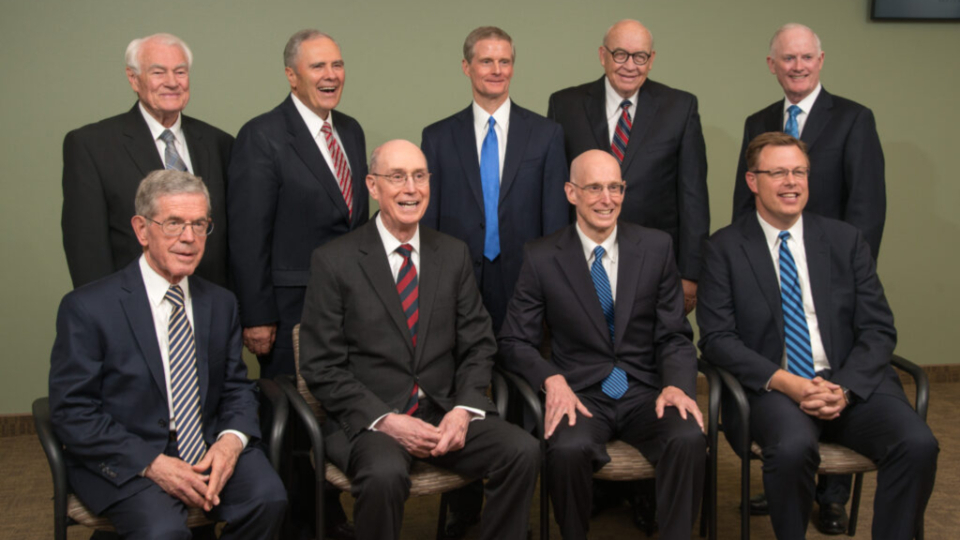
BYUI-20-Anniversary
Nine Ricks College and BYU–Idaho presidents gather for a photo on September 19, 2017, for the inauguration of the school’s 17th president. Front row (left to right): Elder Bruce C. Hafen, President Henry B. Eyring, President Henry J. Eyring, Elder Clark G. Gilbert. Back row (left to right): Elder Joe J. Christensen, President Stephen Bennion, Elder David A. Bednar, President Robert Wilkes, Elder Kim B. Clark. Photo by Michael Lewis, courtesy of Church News.Copyright 2021 Deseret News Publishing Company.In looking back, Elder Bednar described the 15 months between President Hinckley’s announcement and the official transition to BYU–Idaho as flying a jetliner at 35,000 feet and trying to repaint, renovate and work on all the mechanical features while it’s in the air.
“You couldn’t say to everybody: ‘Well, excuse us. We’ll be back in 18 months when we have this all worked out.’ So we had to continue running a two-year school while we were becoming a four-year school,” Elder Bednar said.
President Bednar and the other administrators had to decide which associate programs would remain, which would be eliminated and which would become baccalaureate degrees. In addition, they had to eliminate the athletics program while creating the student-driven activities program. They also implemented the three-track calendaring and admissions program and reevaluated campus space and a host of other programs and procedures.
“It was a crazy time,” said Betty Oldham, who worked as the president’s assistant at that time. “But it was probably one of the most spiritual experiences I have ever had, because we saw miracles unfold and revelation was given.”
Said Elder Bednar. “The Lord’s hand was in every aspect of that endeavor.”
There were a few who struggled or were disappointed with aspects of the changes. However, Wilkes noted, “Most of the time it was just a matter of helping people feel good about it and become part of the answer.”
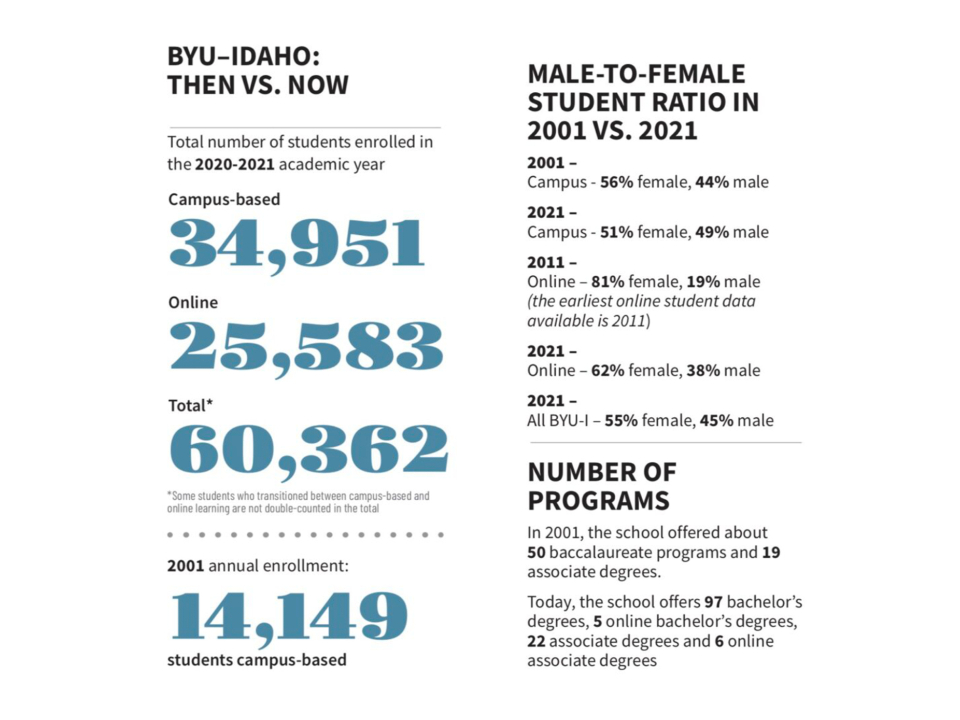
BYUI-20-Anniversary
Graphic courtesy of Church News.Copyright 2021 Deseret News Publishing Company.Oldham remembered sitting in a meeting with President Bednar and the administration vice presidents when President Bednar announced that President Hinckley was going to make the school a four-year university.
“What happened in that meeting set the tone because many of the vice presidents had deep roots to Ricks College with family who were Snake River Valley [or] Ricks College people,” Oldham said. “But to a person, the response was simply ‘What do we need to do, President?’”
Most of the challenges of that year were logistical and physical, Elder Bednar said. “But the nature of the people, the quality of the people, was what made it possible to overcome those challenges.”
In an article published soon after the official transition, Elder Bednar told the Church News, “I can’t think of a time I’ve worked harder. People on campus have worked to make this happen. You have to work like it depends on you but recognize the Lord’s part.”
On the night before President Hinckley made the public announcement, Oldham was at the copy machine finishing up a project as President Bednar was leaving. “Does any of this scare you?” she asked.
“If I thought I was doing this alone I’d be scared to death,” President Bednar replied, “but I know who’s in charge.”
Oldham said that exchange changed her perspective in many ways. “It wasn’t about him, it wasn’t about us. It was about making it the school the Lord needed it to be and He would guide every step of the way.”
The fact that the school went from being a junior college to having fully accredited baccalaureate programs in a year is incredible, Elder Clark remarked. “It’s almost unbelievable. People worked really hard, and the Lord blessed them and used them here. It was miraculous.”
Preserving the Spirit of Ricks
In a campus devotional address offered roughly a month after the school’s official launch as BYU–Idaho, Elder Henry B. Eyring, then a member of the Quorum of the Twelve Apostles and former Ricks College president, said that someday an employer who has hired a BYU–Idaho student will be astounded by that student’s leadership and resourcefulness and ask, “Where did that come from?”
“And I’ll smile and say, ‘Well, come with me to Rexburg,’” Elder Eyring said. “And I may not be able to show it to you, and I may not be able to prove it to you, but you’ll feel it.”
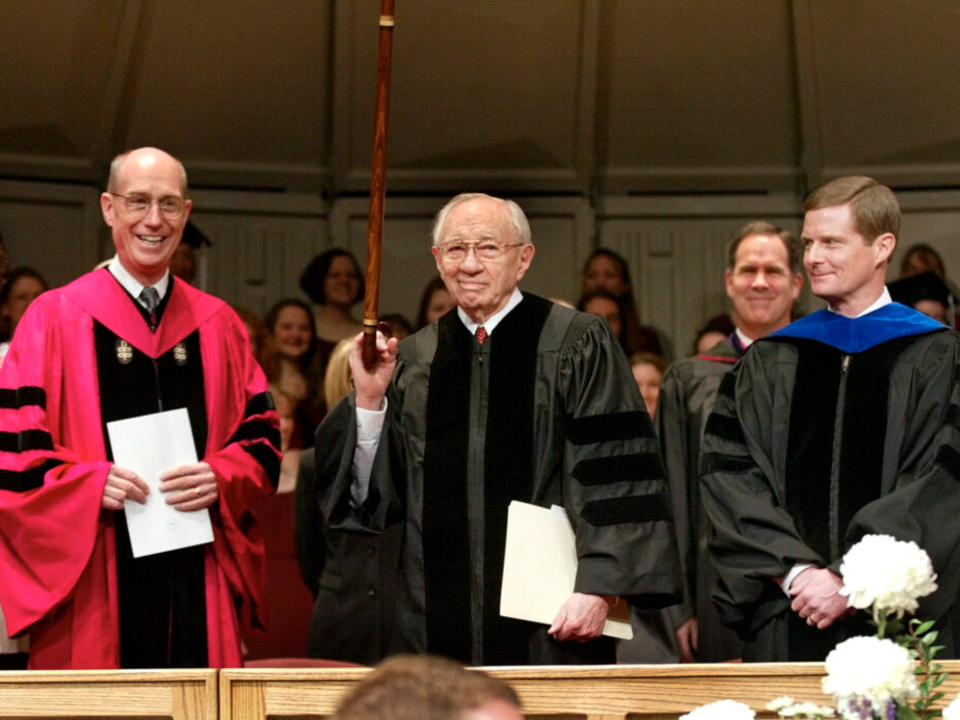
BYUI-20-Anniversary
President Gordon B. Hinckley stands between Elder Henry B. Eyring (left) and BYU–Idaho University David A. Bednar (right) and waves good-bye to graduates and guests at the first BYU–Idaho commencement ceremonies. Photo courtesy of Church News.Copyright 2021 Deseret News Publishing Company.That feeling that permeates campus has often been referred to as “the Spirit of Ricks” and was a defining characteristic of Ricks College that school administrators and leaders have strived to preserve.
“From the very beginning, we emphasized the fact that BYU–Idaho would be characterized by the spirit of Ricks,” Elder Bednar told the Church News. “The spirit of Ricks is not just being friendly. The spirit of Ricks ultimately is the Holy Ghost, who enlightens the mind, brings joy to the spirit and to the soul.”
The spirit of Ricks is exemplified by a faculty member who notices that a student is absent from class for three consecutive periods and seeks out the student to find out what’s going on and how they can help them get caught up, Elder Bednar explained. “You don’t find that at many four-year universities. That was characteristic of Ricks College. That’s the Holy Ghost, inspiring a covenant-keeping disciple of Christ to be concerned about one student. So we simply said, ‘We are not going to lose that quality as we become BYU–Idaho.’”
Elder Clark said when he became president, the administration and faculty expended “a significant amount of effort” to preserve the spirit that’s found on campus. “You can just feel the spirit all day long when you’re on that campus,” Elder Clark said. “And we worked really hard to have that same kind of spirit of love and humility and frugality and obedience that brought the Spirit of the Lord there.”
President Hinckley’s announcement mentioned that there would be minimal changes to the school’s mission, which is “to develop disciples of Jesus Christ who are leaders in their homes, the Church and their communities,” Garrett said.
“I think one of the best ways we can honor the legacy of Ricks College today is by really focusing on our DNA and the purpose of why we’re here: to develop disciples of Jesus Christ,” Garrett said.
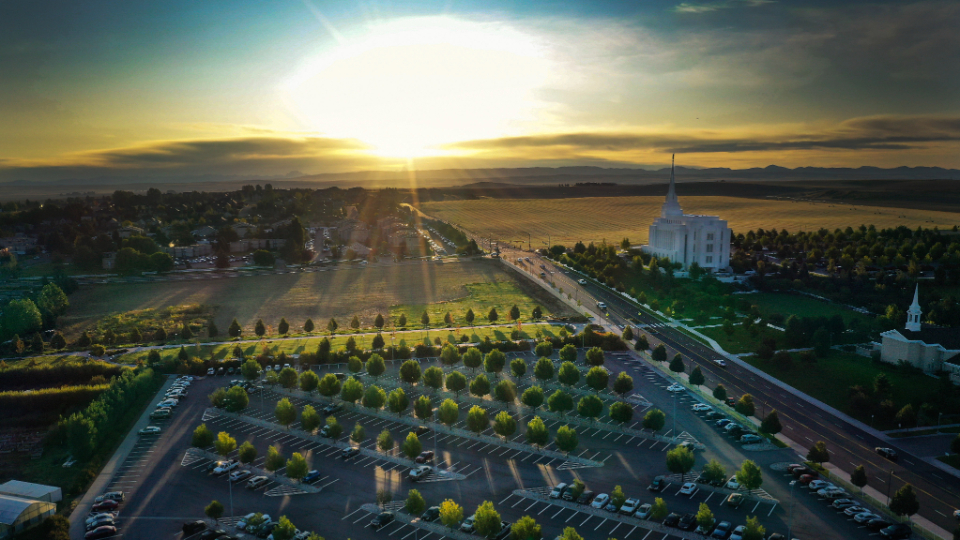
BYUI-20-Anniversary
The sun rises on BYU–Idaho campus and the Rexburg Idaho Temple in Rexburg on Monday, September 23, 2019. Photo by Jeffrey D. Allred, courtesy of Church News.Copyright 2021 Deseret News Publishing Company.‘Rethinking Education’
One of BYU–Idaho’s hallmarks is its innovative spirit, which is reflected in its motto: “Rethinking Education.” President Eyring said during his campus devotional address in 2001 that the phrase “rethinking education” is not simply a slogan. “The school is to be a place of educational innovation permanently.”
During Elder Bednar’s involvement as president of a transitioning educational entity, “we had to reexamine everything,” he recalled. “BYU–Idaho is all about rethinking education. We rethought how to admit students. We had to rethink how and when students attend the school. We had to rethink the nature of internships.”
One early innovation the school implemented was the three-track calendaring system, which allowed it to serve many more students while keeping class sizes small. “Instead of thinking that school is only from September until April and then having the physical plant and all the facilities underutilized for the summer, you use it all year-round,” Elder Bednar explained. “So you increase by a very significant percentage how many students can be admitted. It’s used year-round.”
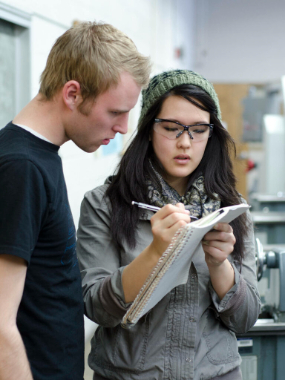
BYUI-20-Anniversary
BYU–Idaho student Alyssa McCarter helps her classmate Mike Cortez with a Manufacturing Processes Lab assignment March 17, 2011. They are taking part in BYU–Idaho’s schoolwide learning model of teaching each other. Photo by Michael Lewis, courtesy of Church News.Copyright 2021 Deseret News Publishing Company.Most universities want to reduce enrollment and then charge each student more money. BYU–Idaho, however, has been able to increase enrollment while reducing the cost per student.
“If the world of higher education is going one way, we’re going to turn around and look and probably go the opposite way,” Elder Bednar observed.
When Elder Clark was asked to take the helm of BYU–Idaho, he said the Lord made it very clear that the university was to pursue three imperatives:
- Increase the quality of the student experience, in all its dimensions
- Find a way to serve a lot more students
- Lower the relative cost of education
“We had to really think hard and change the way we approached some things,” Elder Clark said.
The first thing the administration did was modify the academic calendar to three equal trimesters. Instead of the summer semester consisting of two shorter terms, it would now be an equal trimester with winter and fall, with full academic programs and full faculty.
They also fully implemented a learning model that encourages students to teach one another and be accountable for their own learning. That became important down the line, Elder Clark explained, when they used it to design the online suite of courses.
Offering more courses online allowed them to increase enrollment once again. If every freshman takes one online class, for example, that allows the school to admit that many more students because there is a seat that’s now available because someone’s not sitting in it.
“It allowed us to serve more students with the space we have and also with the faculty we have,” Elder Clark said, “and so we were able to grow the student body significantly more than otherwise we would have been able to at the same cost.”
The next innovation to begin during that period was the advent of the BYU–Pathway Worldwide program. BYU–Idaho created the first-ever PathwayConnect sites in Nampa, Idaho; Mesa, Arizona; and Manhattan, New York. Roughly a month after the initial launch, Elder Clark recalled sitting in general conference and having a clear spiritual impression: “You need to expand Pathway. You need to go international. And you need to do it now.”
They soon received approval to expand to 10 sites, with one in Mexico and one in Ghana. Today, BYU–Pathway Worldwide has expanded to 150 countries around the world.
And although BYU–Pathway Worldwide is now an independent entity, it continues to work in partnership with BYU–Idaho to grow online enrollment all across the world. BYU–Idaho online instructors and course development efforts remain pillars of the entire program.
President Gilbert spoke of how BYU–Idaho has always been a leader in doing more with less. “Ironically, people think, ‘Well I need more money to fund innovation.’ What I learned at BYU–Idaho is frugality can often lead to innovation. And I learned more about innovating with less from my time serving at BYU–Idaho than in all of my years studying innovation at the Harvard Business School.”
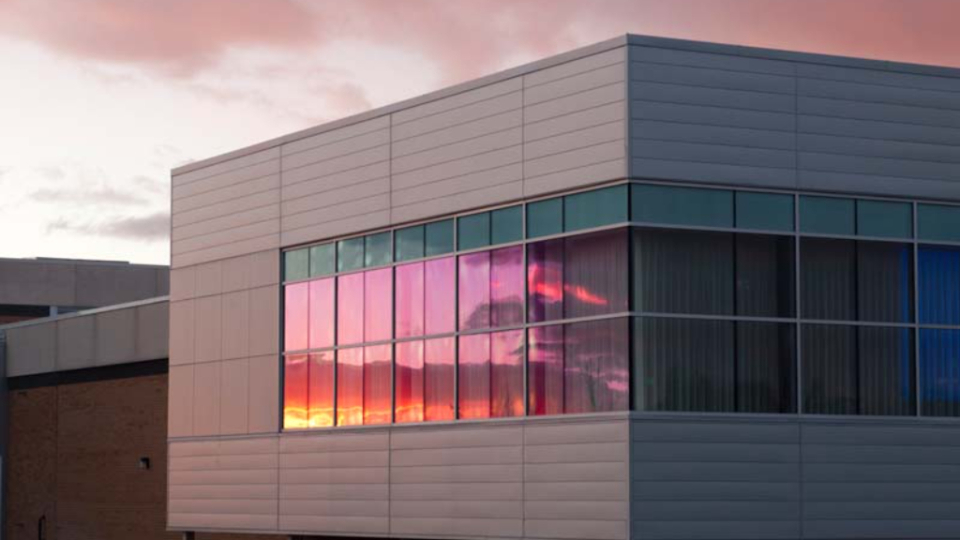
BYUI-20-Anniversary
Photos of the new BYU–Idaho Center and remodeled Manwaring Center in Rexburg, Idaho on Thursday, December 16, 2010. Photo by Michael Lewis, courtesy of Church News.Copyright 2021 Deseret News Publishing Company.Potential of Church Education
As Elder Clark thought back over the past 20 years on the changes within BYU–Idaho and Church education, scripture came to mind. “For I, the Lord, have put forth my hand to exert the powers of heaven; ye cannot see it now, yet a little while and ye shall see it, and know that I am, and that I will come and reign with my people” (Doctrine and Covenants 84:119).
“The Lord is saying: ‘I have put forth my hand and I am exerting the powers of heaven. You can’t see it quite yet. In time you’ll see it. And when you see it, you’ll know that I am.’ You can see this happening in so many aspects of the Church,” Elder Clark said. “You can see it happening in education across the Church.”
And this is just the beginning, Elder Clark said. The Lord is going to bless His children through education. “We can see Him moving with power, and I’ll tell you I’ve lived it. I lived it at BYU–Idaho, and I lived it when I was commissioner of education. It’s just amazing and wonderful to see, and there’s so much joy. You just rejoice that the Lord is doing His work.”
Copyright 2021 Deseret News Publishing Company.